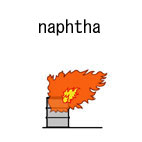| Case Name |
Fire of cracked naphtha leaked from piping changed on an emergency shutdown |
| Pictograph |

|
| Date |
May 31, 1999 |
| Place |
Kawasaki, Kanagawa, Japan |
| Location |
Refinery |
| Overview |
A fire occurred on switching of the cracked naphtha rundown line in the gasification-desulfurization unit of a refinery on May 31st, 1994. Due to an emergency shutdown caused by a power failure, cracked naphtha was sent to the piping that was not usually used. In this piping, local corrosion had progressed and there were open holes. The leakage happened after sending the distillate. The leaked naphtha made contact with high-temperature piping and ignited. |
| Incident |
A power failure occurred in the Mizue district of Kawasaki Ward. The emergency shutdown system operated with the electric power selection shutdown system of the refinery. Under the program of an emergency shutdown, cracked naphtha of a gasification-desulfurization unit was distilled automatically into a semi-finished goods tank, not into the cracked naphtha distillation and washing unit. Afterwards, an operator on patrol found cracked naphtha spouting from the naphtha piping on the pipe rack. This piping was located about 7 m above the ground. The operator called for support using a portable transceiver. At that time, flames appeared from neighboring piping about 3 m away from the leak. Refer to Fig2. |
| Processing |
Manufacture |
| Individual Process |
Rundown and taking-out |
| Substance |
Naphtha |
| Type of Accident |
Leakage, fire |
| Sequence |
On May 31st, 1999. At about 11:25.
A power failure occurred in the Mizue district of Kawasaki Ward.
About 11:46. The electric power shutdown system and the emergency shutdown system at the site operated. Cracked gas recovery equipment was checked by a patrol. The operator on patrol found a fire of cracked naphtha leaking from naphtha rundown piping.
11:47. An emergency call was made.
11:51. The leakage position was covered with a rubber belt. The piping pinhole part was closed.
11:52. The fire was extinguished. |
| Cause |
The electric power shutdown system of the refinery operated because the supply of electric power from the electric power company was stopped, and the emergency shutdown system of the equipment operated. As a result, cracked naphtha of gasification-desulfurization equipment was distilled automatically into a semi-finished product tank not into the cracked naphtha distillation and washing unit. At this time, local corrosion had progressed in the piping connected to the tank and there were open holes. Therefore, the cracked naphtha leaked and made contact with the neighboring high-temperature piping flange. It was considered that the leaked naphtha permeated into the heat insulation of the piping, reached an ignition temperature, and ignited. |
| Response |
Covering with a rubber belt at the position of leakage. (The piping pinhole was closed). |
| Countermeasures |
1. Use of the piping was forbidden until turnaround shutdown maintenance in fiscal year 2000. Full renewal of piping was done in 2000.
2. Similar piping was checked thoroughly.
3. The security standard for piping was established.
4. An inspection interval was scheduled.
5. Management of inspection was kept strictly. |
| Knowledge Comment |
Maintenance of piping that is not usually used is apt to be neglected. However, the same maintenance as that of regularly used piping is necessary. |
| Background |
The piping to the semi-finished product tank had been remodeled and had been used in common with another plant for 11 years before the accident. The piping had only a small flow, and the condition inside the piping promoted corrosion by two-phase separation of vapor-liquid. A couple of times, the piping was renewed and also in the next year, renewal was planned. Local corrosion progressed in the piping, and there were open holes. The cracked naphtha was sent through this piping at the time of the power failure, and naphtha leaked. The leaking naphtha made contact with high-temperature piping and ignited. Inadequate facility management was a basic factor. |
| Incidental Discussion |
Unfortunately, this accident happened at piping for which a renewal construction plan had already been decided. |
| Reason for Adding to DB |
Example of fire caused due to poor maintenance of emergency piping |
| Scenario |
| Primary Scenario
|
Poor Value Perception, Poor Safety Awareness, Inadequate Risk Recognition, Misjudgment, Misjudgment of Situation, Emergency Use Only, Usage, Maintenance/Repair, Insufficient Inspection, Failure, Abrasion, Corrosion, Failure, Fracture/Damage, Opening, Secondary Damage, External Damage, Fire
|
|
| Sources |
Kawasaki City Fire fighting station. Prevention division. Peace section. Naphtha piping leakage fire. Material of the Kawasaki City complex safety countermeasures committee. (1999)
|
| Physical Damage |
Heat insulation of piping was damaged by fire. About 10 liters of cracked naphtha burned. |
| Financial Cost |
¥ 100 thousand (Material of the Kawasaki City complex safety countermeasures committee) |
| Multimedia Files |
Fig2.Site sketch
|
| Field |
Chemicals and Plants
|
| Author |
DOBASHI, Ritsu (School of Engineering, The University of Tokyo)
TAMURA, Masamitsu (Center for Risk Management and Safety Sciences, Yokohama National University)
|